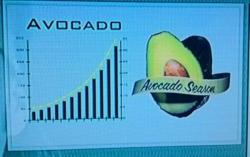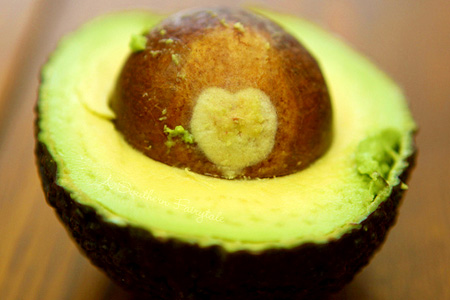When I was a kid in upstate New York, we didn’t eat avocados. Until I moved to California, I may never have eaten one. Maybe guacamole, but I don’t remember it, and I think that eating green paste would have made some sort of imprint. (I’d also never had jicama, but that’s a different category of odd.) Basically the entire extent of my familiarity with the things was an insult my sister made up, calling me “avoca-toes” for no real reason.
But maybe the problem wasn’t growing up in Rochester. Maybe it was growing up several decades ago.

Avocados, in a bag, waiting. (Photo by Nate Steiner.)
From the Wall Street Journal:
With more people paying close attention to diet and health, more single produce items are rocketing to superstardom. …
Such is the case with avocados. Mexican imports, available in all 50 states only since 2007, have led to year-round availability and now contribute more than 60% of U.S. supply. Avocado sales in 2011 totaled $2.9 billion, beating 2010 by 11%, according to the Hass Avocado Board, based in Irvine, Calif. Consumption in the first half of 2012 was 30% ahead of the same period last year.
Thirty percent! Americans in the first half of 2012 ate almost one-third more avocados than they did the year prior.
When this story first broke last night, a lot of people had a similar thought: Subway.

Subway’s avocado graph, in a photograph of a television screen taken by a journalist at Gawker.com. (Photo by Max Read.)
Subway pushed avocados hard during the Olympics in particular. Its ads (including the one above) show a graph of rapid avocado increase, which is well-analyzed in this important blog post. “Fresh veggies, with super foods spinach and avocado,” Subway promised America. Super foods like the Olympians eat.
We should note that even “super foods” should be enjoyed with caution.
Fats, no matter how healthy, shouldn’t make up more than a third of daily caloric intake, [dietician Barbara] Davis cautions. One ounce of avocado, equal to about two tablespoons, or a fifth of a medium-size fruit, provides 4.5 grams of fat. Indulge in a whole avocado, and rack up 250 calories and 22.5 grams of fat. “A ‘super food’ isn’t something you can eat unlimited amounts of,” Ms. Davis says.
Avocado growers, on the other hand, are happy to have us throw caution (and our waistlines) to the wind.
In consumers’ minds, the avocado has been transformed from exotic “fatty food” to everyday source of “heart-healthy” fats. “We fought the health message for years and years. A fat was a fat was a fat,” says Mike Browne, marketing committee chairman for the Mexican Hass Avocado Importers Association, a Fallston, Md., marketing group. Now, he says, “the stars have aligned.”
The times they are a-changing. And, among other things, there is now a great place to get avocados about a half-mile from the street where I grew up. Subway.



